Surgical treatment of shoulder impingement syndrome is not effective
Keywords:Impingement syndrome is a common condition with a typical symptom called “painful arc”, where you experience pain when lifting your arm and especially when your arm is level. The root cause of the symptom is unclear, but it is assumed that the pain is caused by irritation of the shoulder’s rotator cuffs and adjacent tissues.

The study changed the treatment of shoulder impingement syndrome. Surgical procedures decreased from 800 to a few every year. The new treatment guidelines include normal use of the arm, mechanical load reduction and, if necessary, pain relief with NSAIDs, cortisone injections, physiotherapy, and exercise therapy.
Previously, it was thought that the shoulder is tight, that is, the rotator cuff rubs on the underside of the acromion and so thinning the acromion, i.e. acromioplasty, could improve the symptom.
Surgical treatment of the impingement syndrome should be avoided, it brings more harm than benefit
According to studies conducted at HUS, acromioplasty has not been an effective treatment: it has not reduced pain, improved functional capacity or quality of life compared to a placebo procedure. Patients recover equally well with non-surgical treatments, and they are spared the surgical procedure and potential complications.
HUS Orthopedics has been involved in the development of a treatment recommendation according to which surgical treatment of impingement syndrome should be avoided, since it brings more harm than benefit. Some of the studies that influenced the recommendation have been conducted at HUS.
Acromioplasty procedures are rarely performed anymore
The study conducted at HUS has significantly impacted the treatment guidelines for the treatment of impingement syndrome both in Finland and internationally. The number of procedures has decreased sharply: In 2011, HUS performed as many as 800 acromioplasty procedures and hundreds of thousands were performed worldwide due to impingement syndrome. These days, hardly any at all are done at HUS.
Reducing surgeries that are ineffective frees up operating room resources for effective procedures, which is essential to the reasonable use of shared resources. For patients, giving up unnecessary surgery is also beneficial as the patient avoids the pain and treatment risks associated with the procedure.
Reducing mechanical load as a treatment method for impingement syndrome
Currently, the treatment of shoulder impingement syndrome is to reduce the load, however, so that the arm is used as normally as possible. If necessary, pain can be alleviated with NSAIDs and cortisone injections, and physiotherapy and exercise therapy may also help.
Orthopedist Tuomas Lähdeoja has studied the effect of surgical treatment of impingement syndrome at HUS.
The effect of surgical treatment of impingement syndrome has been studied at HUS by Orthopedist Tuomas Lähdeoja at HUS Musculoskeletal and Plastic Surgery. He was also involved in developing the international treatment recommendation.
The Fimpact study was led by Mika Paavola, Orthopedist and Head of Orthopedics and Traumatology at HUS Musculoskeletal and Plastic Surgery.
Further information
- BMJ Rapid Recommendation article: Subacromial decompression surgery for adults … (opens in new window, links to another website)
- Meta-analysis of the effect of acromioplasty: Subacromial decompression surgery… (opens in new window, links to another website)
- FIMPACT study on acromioplasty: Subacromial decompression versus diagnostic art… (opens in new window, links to another website)
- Number of shoulder procedures in Finland 2012–2021 (opens in new window, links to another website)